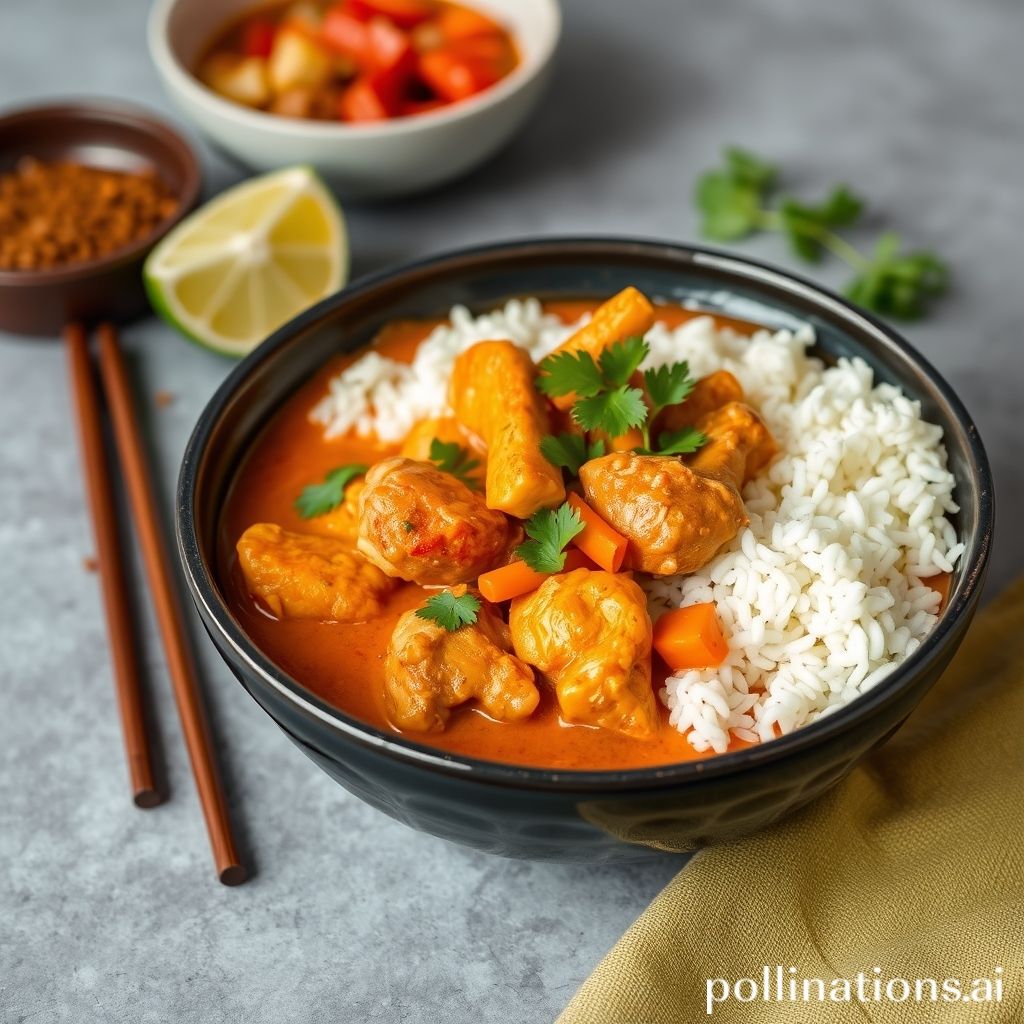Table of Contents
- Introduction
- Ingredients for Thai Red Curry Chicken
- Preparing the Thai Red Curry paste
- Cooking the chicken and vegetables
- Adding the coconut milk and seasoning
- Serving the Thai Red Curry Chicken
- Conclusion
- Frequently Asked Questions
Introduction
Savor the Spices: A Mouthwatering Journey into Thai Red Curry Chicken
Ingredients for Thai Red Curry Chicken
Thai Red Curry Chicken is a delicious and flavorful dish that combines tender chicken with a rich and spicy red curry sauce. The key to making an authentic Thai Red Curry Chicken is using the right combination of ingredients. Here are the essential ingredients:
1. Chicken: Use boneless, skinless chicken breasts or thighs, sliced into bite-sized pieces.
2. Red Curry Paste: This is the star ingredient that gives the dish its vibrant color and spicy flavor. You can either make your own red curry paste or buy it from a store.
3. Coconut Milk: This creamy ingredient provides a rich and silky base for the curry sauce.
4. Fish Sauce: A staple in Thai cuisine, fish sauce adds a savory and salty element to the dish.
5. Kaffir Lime Leaves: These aromatic leaves add a citrusy and herbal note to the curry.
6. Thai Basil: This fragrant herb adds a fresh and slightly sweet flavor to the dish.
7. Vegetables: You can add a variety of vegetables such as bell peppers, bamboo shoots, and eggplant to enhance the dish’s texture and taste.
Preparing the Thai Red Curry paste
Preparing the Thai Red Curry paste is a crucial step in creating a delicious and authentic Thai Red Curry Chicken dish. The paste is what gives the curry its distinct flavor and spice. While it is readily available in stores, making your own paste from scratch allows you to customize the ingredients and achieve a bold and fresh taste.
To prepare the Thai Red Curry paste, you will need various ingredients such as red chili peppers, garlic, ginger, lemongrass, shallots, shrimp paste, coriander seeds, cumin seeds, and lime zest. These ingredients are traditionally pounded together in a mortar and pestle to create a smooth and fragrant paste.
Start by removing the seeds from the chili peppers and chopping them into small pieces. Peel and slice the garlic, ginger, and shallots. Bruise the lemongrass stalks to release their flavor. In the mortar and pestle, combine all the ingredients and grind them until a thick paste is formed.
Alternatively, if you don’t have a mortar and pestle, you can use a blender or food processor to grind the ingredients into a paste-like consistency. Just be sure not to over-process, as you want to maintain the texture and aroma of the ingredients.
Once the Thai Red Curry paste is ready, you can use it to marinate chicken, vegetables, or any protein of your choice before cooking the curry. The paste can also be stored in an airtight container in the refrigerator for future use.
Cooking the chicken and vegetables
To cook Thai Red Curry Chicken, start by marinating boneless chicken pieces in a mixture of red curry paste, coconut milk, soy sauce, and lime juice for at least 30 minutes. While the chicken is marinating, prepare the vegetables. You can use a combination of bell peppers, broccoli, carrots, and snap peas. Cut them into bite-sized pieces.
In a large skillet or wok, heat some oil over medium-high heat. Add the marinated chicken and cook until browned on all sides and cooked through. Remove the chicken from the skillet and set it aside.
In the same skillet, add more oil if needed, and then add the prepared vegetables. Stir-fry them for a few minutes until they start to soften but are still crisp. Add some minced garlic and grated ginger for added flavor.
Next, pour in the remaining marinade and some additional coconut milk. Stir in a tablespoon of fish sauce and a teaspoon of sugar. Return the cooked chicken to the skillet and let everything simmer for a few minutes until the flavors meld together.
Finally, taste and adjust the seasoning as needed. Serve the Thai Red Curry Chicken over steamed jasmine rice, garnished with fresh basil leaves and sliced red chili peppers. Enjoy!
Adding the coconut milk and seasoning
Once the chicken and vegetables are cooked to perfection, it’s time to add the star ingredient that gives Thai Red Curry Chicken its rich and creamy texture – coconut milk. Coconut milk not only adds a velvety smoothness to the dish, but it also helps to balance out the spiciness of the curry paste.
Gently pour in the coconut milk and stir it into the chicken and vegetables. The creamy white liquid will blend with the vibrant red curry paste, creating a beautiful orange hue that is a trademark of this dish.
After adding the coconut milk, it’s time to season the curry. This is where you can adjust the flavors to suit your taste preferences. You can add salt to enhance the overall taste or a splash of fish sauce for a savory umami kick. If you prefer a sweeter curry, a touch of sugar or palm sugar can be added. And for those who crave a bit more heat, a sprinkle of chili flakes or a drizzle of chili oil can do the trick.
Once you’ve added the coconut milk and seasoned the curry, let it simmer for a few more minutes to allow the flavors to meld together. This will ensure that each spoonful of Thai Red Curry Chicken is bursting with deliciousness.
Serving the Thai Red Curry Chicken
Serving Thai Red Curry Chicken is an enjoyable and delicious experience. This flavorful dish can be served in various ways to suit different preferences and dietary needs.
One popular option is to serve Thai Red Curry Chicken over a bed of steamed jasmine rice. The creamy and spicy curry pairs perfectly with the fragrant and fluffy rice, creating a satisfying and balanced meal.
For those who prefer a lighter option, Thai Red Curry Chicken can also be served with noodles. Rice noodles or egg noodles can be boiled and then tossed in the curry sauce along with the chicken. This creates a noodle dish with a delightful blend of flavors and textures.
To add some freshness and crunch to the dish, consider serving Thai Red Curry Chicken with a side of crispy vegetables. Sautéed or stir-fried vegetables such as bell peppers, broccoli, and snap peas complement the curry well and provide a contrast in textures.
Finally, garnishing the dish with fresh herbs such as cilantro or Thai basil can enhance the flavors and add an appealing visual element. The herbs can be sprinkled on top of the curry or used as a garnish on the plate.
Overall, serving Thai Red Curry Chicken offers a versatile dining experience, allowing individuals to customize the dish according to their taste and preferences.
Conclusion
If you’re tired of boring chicken dishes and are ready to elevate your culinary game, look no further than The Chicken Bible: Say Goodbye to Boring Chicken with 500 Recipes for Easy Dinners, Braises, Wings, Stir-Fries, and So Much More! This comprehensive cookbook is a must-have for any chicken lover, providing a diverse range of 500 delicious recipes that will keep your taste buds tantalized and your dinner table exciting.
With The Chicken Bible, you’ll never run out of ideas for how to prepare this versatile meat. From easy weeknight dinners to impressive braises, flavorful wings, and mouthwatering stir-fries, this book covers it all. Whether you’re a beginner in the kitchen or an experienced home cook, the clear and concise instructions make it easy to recreate these amazing dishes.
Ready to say goodbye to boring chicken and explore a world of culinary possibilities? Get your copy of The Chicken Bible today and indulge in 500 irresistible chicken recipes! Click here to purchase now!

